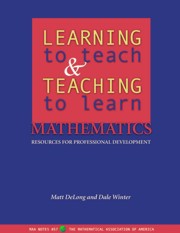Book contents
- Frontmatter
- Preface
- Contents
- 1 The Professional Development Program
- 2 How to Use this Book
- 3 An Orientation Session for the Beginning of the Semester
- 4 Making In-class Groups Work
- 5 Getting Students to Read the Textbook
- 6 Assessing and Evaluating Students' Work
- 7 Managing Homework Teams
- 8 Teaching During Office Hours
- 9 Establishing and Maintaining Control in Your Classroom
- 10 Proctoring Tests and Examinations
- 11 Teaching with Calculators and Computers
- 12 Making Lesson Plans
- 13 Strategies for Motivating Students
- 14 Dealing With Difficult Instructor-Student Situations
- 15 End-of-Semester Administration
- 16 Adapting Materials and Designing Your Own Meetings
- 17 Classroom Visits
- A Tips for Running Meetings
- B The Michigan Introductory Program
- Bibliography
14 - Dealing With Difficult Instructor-Student Situations
- Frontmatter
- Preface
- Contents
- 1 The Professional Development Program
- 2 How to Use this Book
- 3 An Orientation Session for the Beginning of the Semester
- 4 Making In-class Groups Work
- 5 Getting Students to Read the Textbook
- 6 Assessing and Evaluating Students' Work
- 7 Managing Homework Teams
- 8 Teaching During Office Hours
- 9 Establishing and Maintaining Control in Your Classroom
- 10 Proctoring Tests and Examinations
- 11 Teaching with Calculators and Computers
- 12 Making Lesson Plans
- 13 Strategies for Motivating Students
- 14 Dealing With Difficult Instructor-Student Situations
- 15 End-of-Semester Administration
- 16 Adapting Materials and Designing Your Own Meetings
- 17 Classroom Visits
- A Tips for Running Meetings
- B The Michigan Introductory Program
- Bibliography
Summary
“The Torch or the Firehose?” is the Math and Physics recitation guide published by MIT and reproduced in [23], on page 185. It notes that,
The classroom and section meeting are the business end of education. Here students and staff deal together with the stuff of the intellect. Here also idiosyncrasies in both become apparent.
In our experience, and as reported in a survey of graduate student instructors' experiences, [121], most instructors who teach a significant number of students will eventually find themselves in an “idiosyncratic” situation.
We distinguish this meeting from the meeting titled, “Establishing and Maintaining Control in Your Classroom” with the observation that in this meeting we are interested in discussing encounters, or more likely a series of encounters, between instructors and particular students. The earlier meeting can be understood as a meeting about gaining and maintaining students' cooperation with the instructor's plans for the class and how those plans are to be executed. In some sense, that meeting was about overcoming difficulties that may be thought of as in some way inherent to the structure and opportunity that an interactive classroom offers to students. That meeting was about addressing difficulties with an entire class of students. The present meeting focuses on addressing difficulties with particular students. Naturally, there may be relationships between the two phenomena here. For example, a particularly difficult student may cause classroom-wide problems when given access to the opportunities for self-directed behavior that the interactive classroom offers.
Information
- Type
- Chapter
- Information
- Learning to Teach and Teaching to Learn MathematicsResources for Professional Development, pp. 169 - 182Publisher: Mathematical Association of AmericaPrint publication year: 2002
